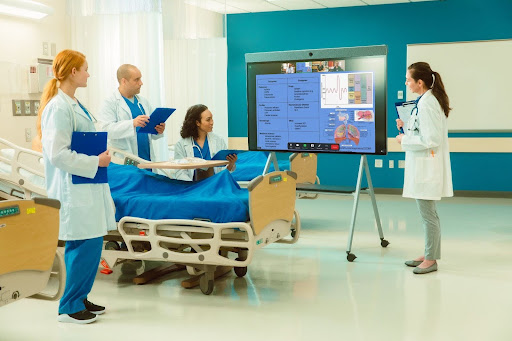
Re-imagining healthcare with Zoom’s AI-first platform
Zoom for Healthcare enables healthcare organizations to deliver seamless experiences across the patient journey and enhance collaboration among providers.
Updated on February 15, 2023
Published on December 11, 2020


With fewer resources, leaner teams, and lower budgets than larger health systems, small healthcare organizations may feel like the most advanced phone solutions are out of reach or too complex for their needs.
The good news is, Zoom Phone makes enterprise-level phone quality and features accessible to small to mid-sized healthcare clinics and hospitals, independent practices, and rural and federally qualified health centers (FQHCs) without a high price tag.
A cloud phone solution like Zoom Phone is an excellent fit for smaller organizations because you get all the telephony functionality of a business phone system in an easy-to-use — and easy-to-manage — solution. Plus, with our healthcare solutions, customers can now use Zoom Phone to keep protected health information (PHI) secure.
Here’s how your clinical practice, FQHC, or hospital can get more from its telephony solution with Zoom Phone.
If your providers are constantly on the go, moving between buildings or from patient appointments to meetings, call flip enables them to seamlessly transfer calls between any device with one button, simply by putting the call on hold and picking it up on another device.
With Zoom Phone, you can instantly elevate a phone call to a video meeting if the need arises — say, during a patient consultation with a remote specialist. You can also merge an incoming call into a three-way call or transfer a call into an existing Zoom meeting.
If you’re on a call with a patient and need to record the interaction on the fly, it’s as easy as pushing a single button, and you’ll receive both the audio file and a transcription. You can turn automatic call recording on and off throughout the entire organization if you prefer.
You can also get voicemails delivered straight to your email inbox as an audio file and transcription. This includes shared voicemails and voicemails to delegated users, so a receptionist could receive a patient voicemail sent to a main line or specific provider. You can even export that voicemail to a patient’s electronic medical record.
Zoom Phone allows you to easily manage your outbound caller ID number with just one click, protecting the privacy of doctors and nurses by allowing them to present their office number instead of their direct line or cell. Not only that, your receptionist or office manager can streamline patient interactions by changing their caller ID to a specific department number, scheduling phone number, or main line when calling patients.
Safety features are critical for healthcare organizations. Emergency calls can be set to not only call 911, but also to alert designated individuals such as an internal safety team, who then has the ability to record, barge, or monitor the 911 call taking place. Along with that, Zoom’s enhanced E911 provides the ability to dynamically track the location of the caller in the event of an emergency.
If you’re a small clinical practice without an IT staff, you may not have the time or expertise to oversee a long, complicated deployment. Many of the features that would normally require coordination with your telecom provider and other third-party companies, such as call flip and call recording, are native to the Zoom Phone platform, meaning you can rapidly deploy Zoom Phone across your organization with ease.
As a cloud-based VoIP phone system, Zoom Phone doesn’t require you to invest in hardware. You can actually use the phone equipment you already have, making it a cost-efficient choice for budget-conscious organizations. Zoom Phone supports almost any device, with interoperability for over 60 vendors of desktop conference phones, intercoms, and paging devices like Poly, Yealink, Algo, CyberData, and Cisco.
Zoom’s unified communications system gives administrators a single pane of glass to manage phone, video communications, and company chat. Admins can easily provision numbers and assign them to users with a process that’s so simple, you don’t need an IT background to do it. Plus, the analytics dashboard gives you insight into issues related to call quality and usage.
Whether your staff members and providers use an Apple or Android, Mac or PC, Zoom Phone works across your desktop and mobile devices with a single client. It’s the same app you use for Zoom Meetings and Zoom Team Chat, meaning your users are already familiar with it.
Check out our webinar to learn more about using Zoom Phone for healthcare with our enhanced BAA license, or read up on the benefits of a cloud business phone system.
Editor’s note: This post was originally published in December 2020 and updated on Feb. 15, 2023, for accuracy.